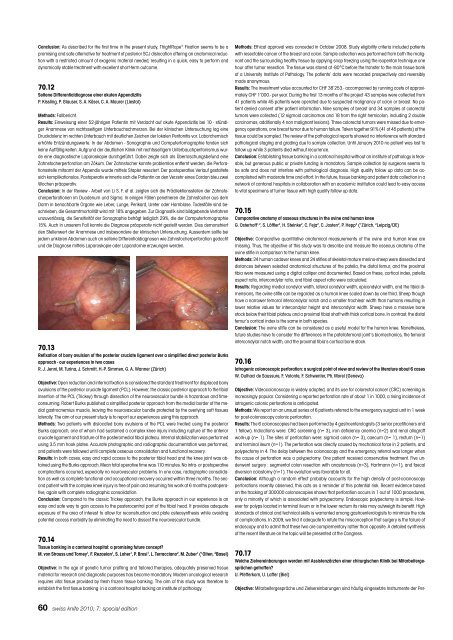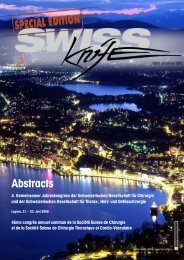Anorectal Manometry in 3D NEW! - Swiss-knife.org
Anorectal Manometry in 3D NEW! - Swiss-knife.org
Anorectal Manometry in 3D NEW! - Swiss-knife.org
Create successful ePaper yourself
Turn your PDF publications into a flip-book with our unique Google optimized e-Paper software.
Conclusion: As described for the first time <strong>in</strong> the present study, ThightRope ® Fixation seems to be a<br />
promis<strong>in</strong>g and safe alternative for treatment of posterior SCJ dislocation offer<strong>in</strong>g an anatomical reduction<br />
with a restricted amount of exogenic material needed, result<strong>in</strong>g <strong>in</strong> a quick, easy to perform and<br />
dynamically stable treatment with excellent short-term outcome.<br />
70.12<br />
Seltene Differentialdiagnose e<strong>in</strong>er akuten Appendizitis<br />
P. Kissl<strong>in</strong>g, P. Glauser, S. A. Käser, C. A. Maurer (Liestal)<br />
Methods: Fallbericht.<br />
Results: E<strong>in</strong>weisung e<strong>in</strong>er 52-jährigen Patient<strong>in</strong> mit Verdacht auf akute Appendizitis bei 10 - stündiger<br />
Anamnese von rechtsseitigen Unterbauchschmerzen. Bei der kl<strong>in</strong>ischen Untersuchung lag e<strong>in</strong>e<br />
Druckdolenz im rechten Unterbauch mit deutlichen Zeichen der lokalen Peritonitis vor. Laborchemisch<br />
erhöhte Entzündungswerte. In der Abdomen - Sonographie und Computertomographie fanden sich<br />
ke<strong>in</strong>e Auffällig-keiten. Aufgrund der deutlichen Kl<strong>in</strong>ik mit rechtsseitigem Unterbauchperitonismus wurde<br />
e<strong>in</strong>e diagnostische Laparoskopie durchgeführt. Dabei zeigte sich als Überraschungsbefund e<strong>in</strong>e<br />
Zahnstocherperforation am Zökum. Der Zahnstocher konnte problemlos entfernt werden, die Perforationsstelle<br />
mitsamt der Appendix wurde mittels Stapler reseziert. Der postoperative Verlauf gestaltete<br />
sich komplikationslos. Postoperativ er<strong>in</strong>nerte sich die Patient<strong>in</strong> an den Verzehr e<strong>in</strong>es Cordon bleu zwei<br />
Wochen präoperativ.<br />
Conclusion: In der Review - Arbeit von Li S. F. et al. zeigten sich die Prädilektionsstellen der Zahnstocherperforationen<br />
im Duodenum und Sigma. In e<strong>in</strong>igen Fällen penetrieren die Zahnstocher aus dem<br />
Darm <strong>in</strong> benachbarte Organe wie Leber, Lunge, Perikard, Ureter oder Harnblase. Todesfälle s<strong>in</strong>d beschrieben,<br />
die Gesamtmortalität wird mit 18% angegeben. Zur Diagnostik s<strong>in</strong>d bildgebende Verfahren<br />
unzuverlässig, die Sensitivität der Sonographie beträgt lediglich 29%, die der Computertomographie<br />
15%. Auch <strong>in</strong> unserem Fall konnte die Diagnose präoperativ nicht gestellt werden. Dies demonstriert<br />
den Stellenwert der Anamnese und <strong>in</strong>sbesondere der kl<strong>in</strong>ischen Untersuchung. Ausserdem sollte bei<br />
jedem unklaren Abdomen auch an seltene Differentialdiagnosen wie Zahnstocherperforation gedacht<br />
und die Diagnose mittels Laparoskopie oder Laparotomie erzwungen werden.<br />
70.13<br />
Refixation of bony avulsion of the posterior cruciate ligament over a simplified direct posterior Burks<br />
approach - our experiences <strong>in</strong> two cases<br />
R. J. Jenni, M. Tur<strong>in</strong>a, J. Schmitt, H.-P. Simmen, G. A. Wanner (Zürich)<br />
Objective: Open reduction and <strong>in</strong>ternal fixation is considered the standard treatment for displaced bony<br />
avulsions of the posterior cruciate ligament (PCL). However, the classic posterior approach to the tibial<br />
<strong>in</strong>sertion of the PCL (Trickey) through dissection of the neurovascular bundle is hazardous and timeconsum<strong>in</strong>g.<br />
Robert Burks published a simplified posterior approach from the medial border of the medial<br />
gastrocnemius muscle, leav<strong>in</strong>g the neurovascular bundle protected by the overly<strong>in</strong>g soft tissues<br />
laterally. The aim of our present study is to report our experiences us<strong>in</strong>g this approach.<br />
Methods: Two patients with dislocated bony avulsions of the PCL were treated us<strong>in</strong>g the posterior<br />
Burks approach, one of whom had susta<strong>in</strong>ed a complex knee <strong>in</strong>jury <strong>in</strong>clud<strong>in</strong>g rupture of the anterior<br />
cruciate ligament and fracture of the posteromedial tibial plateau. Internal stabilization was performed<br />
us<strong>in</strong>g 3.5 mm hook plates. Accurate photographic and radiographic documentation was performed,<br />
and patients were followed until complete osseous consolidation and functional recovery.<br />
Results: In both cases, easy and rapid access to the posterior tibial head and the knee jo<strong>in</strong>t was obta<strong>in</strong>ed<br />
us<strong>in</strong>g the Burks approach. Mean total operative time was 110 m<strong>in</strong>utes. No <strong>in</strong>tra- or postoperative<br />
complications occurred, especially no neurovascular problems. In one case, radiographic consolidation<br />
as well as complete functional and occupational recovery occurred with<strong>in</strong> three months. The second<br />
patient with the complex knee <strong>in</strong>jury is free of pa<strong>in</strong> and resum<strong>in</strong>g his work at 6 months postoperative,<br />
aga<strong>in</strong> with complete radiographic consolidation.<br />
Conclusion: Compared to the classic Trickey approach, the Burks approach <strong>in</strong> our experience is an<br />
easy and safe way to ga<strong>in</strong> access to the posterocentral part of the tibial head. It provides adequate<br />
exposure of the area of <strong>in</strong>terest to allow for reconstruction and plate osteosynthesis while avoid<strong>in</strong>g<br />
potential access morbidity by elim<strong>in</strong>at<strong>in</strong>g the need to dissect the neurovascular bundle.<br />
70.14<br />
Tissue bank<strong>in</strong>g <strong>in</strong> a cantonal hospital: a promis<strong>in</strong>g future concept?<br />
M. von Strauss und Torney 1 , F. Rezaeian 1 , S. Loher 1 , P. Brosi 1 , L. Terracciano 2 , M. Zuber 1 ( 1 Olten, 2 Basel)<br />
Objective: In the age of genetic tumor profil<strong>in</strong>g and tailored therapies, adequately preserved tissue<br />
material for research and diagnostic purposes has become mandatory. Modern oncological research<br />
requires vital tissue provided by fresh frozen tissue bank<strong>in</strong>g. The aim of this study was therefore to<br />
establish the first tissue bank<strong>in</strong>g <strong>in</strong> a cantonal hospital lack<strong>in</strong>g an <strong>in</strong>stitute of pathology.<br />
60 swiss <strong>knife</strong> 2010; 7: special edition<br />
Methods: Ethical approval was conceded <strong>in</strong> October 2008. Study eligibility criteria <strong>in</strong>cluded patients<br />
with resectable cancer of the breast and colon. Sample collection was performed from both the malignant<br />
and the surround<strong>in</strong>g healthy tissue by apply<strong>in</strong>g snap freez<strong>in</strong>g us<strong>in</strong>g the isopentan technique one<br />
hour after tumor resection. The tissue was stored at -80°C before the transfer to the ma<strong>in</strong> tissue bank<br />
of a University Institute of Pathology. The patients’ data were recorded prospectively and reversibly<br />
made anonymous.<br />
Results: The <strong>in</strong>vestment value accounted for CHF 38’253.- accompanied by runn<strong>in</strong>g costs of approximately<br />
CHF 1’000.- per year. Dur<strong>in</strong>g the first 13 months of the project 43 samples were collected from<br />
41 patients while 45 patients were operated due to suspected malignancy of colon or breast. No patient<br />
denied consent after patient <strong>in</strong>formation. N<strong>in</strong>e samples of breast and 34 samples of colorectal<br />
tumors were collected (12 sigmoid carc<strong>in</strong>omas and 18 from the right hemicolon, <strong>in</strong>clud<strong>in</strong>g 2 double<br />
carc<strong>in</strong>omas, additionally 4 non malignant lesions). Three colorectal tumors were missed due to emergency<br />
operations, one breast tumor due to human failure. Taken together 91% (41 of 45 patients) of the<br />
tissue could be sampled. The review of the pathological reports showed no <strong>in</strong>terference with standard<br />
pathological stag<strong>in</strong>g and grad<strong>in</strong>g due to sample collection. Until January 2010 no patient was lost to<br />
follow up while 3 patients died without recurrence.<br />
Conclusion: Establish<strong>in</strong>g tissue bank<strong>in</strong>g <strong>in</strong> a cantonal hospital without an <strong>in</strong>stitute of pathology is feasable,<br />
but generous public or private fund<strong>in</strong>g is mandatory. Sample collection by surgeons seems to<br />
be safe and does not <strong>in</strong>terfere with pathological diagnosis. High quality follow up data can be accomplished<br />
with moderate time and effort. In the future, tissue bank<strong>in</strong>g and patient data collection <strong>in</strong> a<br />
network of cantonal hospitals <strong>in</strong> collaboration with an academic <strong>in</strong>stitution could lead to easy access<br />
to vital specimens of tumor tissue with high quality follow up data.<br />
70.15<br />
Comparative anatomy of osseous structures <strong>in</strong> the ov<strong>in</strong>e and human knee<br />
G. Osterhoff 1,2 , S. Löffler 2 , H. Ste<strong>in</strong>ke 2 , C. Feja 2 , C. Josten 2 , P. Hepp 2 ( 1 Zürich, 2 Leipzig/DE)<br />
Objective: Comparative quantitative anatomical measurements of the ov<strong>in</strong>e and human knee are<br />
miss<strong>in</strong>g. Thus, the objective of this study was to describe and measure the osseous anatomy of the<br />
ov<strong>in</strong>e stifle <strong>in</strong> comparison to the human knee.<br />
Methods: 24 human cadaver knees and 24 stifles of skeletal-mature mer<strong>in</strong>o-sheep were dissected and<br />
distances between selected anatomical structures of the patella, the distal femur, and the proximal<br />
tibia were measured us<strong>in</strong>g a digital calliper and documented. Based on these, cortical <strong>in</strong>dex, patella<br />
aspect ratio, <strong>in</strong>tercondylar ratio, and tibial aspect ratio were calculated.<br />
Results: Regard<strong>in</strong>g medial condylar width, lateral condylar width, epicondylar width, and the tibial dimensions,<br />
the ov<strong>in</strong>e stifle can be regarded as a human knee scaled down by one third. Sheep though<br />
have a narrower femoral <strong>in</strong>tercondylar notch and a smaller trochlear width than humans result<strong>in</strong>g <strong>in</strong><br />
lower relative values for <strong>in</strong>tercondylar height and <strong>in</strong>tercondylar width. Sheep have a massive bone<br />
stock below their tibial plateau and a proximal tibial shaft with thick cortical bone. In contrast, the distal<br />
femur’s cortical <strong>in</strong>dex is the same <strong>in</strong> both species.<br />
Conclusion: The ov<strong>in</strong>e stifle can be considered as a useful model for the human knee. Nonetheless,<br />
future studies have to consider the differences <strong>in</strong> the patellofemoral jo<strong>in</strong>t’s biomechanics, the femoral<br />
<strong>in</strong>tercondylar notch width, and the proximal tibia’s cortical bone stock.<br />
70.16<br />
Iatrogenic colonoscopic perforation: a surgical po<strong>in</strong>t of view and review of the literature about 6 cases<br />
W. Oulhaci de Saussure, F. Volonte, F. Schwenter, Ph. Morel (Geneva)<br />
Objective: Videocolonoscopy is widely adopted, and its use for colorectal cancer (CRC) screen<strong>in</strong>g is<br />
<strong>in</strong>creas<strong>in</strong>gly popular. Consider<strong>in</strong>g a reported perforation rate of about 1 <strong>in</strong> 1000, a ris<strong>in</strong>g <strong>in</strong>cidence of<br />
iatrogenic colonic perforations is anticipated.<br />
Methods: We report on an unsual series of 6 patients referred to the emergency surgical unit <strong>in</strong> 1 week<br />
for post-colonoscopy colonic perforation.<br />
Results: The 6 colonoscopies had been performed by 4 gastroenterologists (3 senior practitioners and<br />
1 fellow). Indications were: CRC screen<strong>in</strong>g (n= 3), iron deficiency anemia (n=2) and renal allograft<br />
work-up (n= 1). The sites of perforation were: sigmoid colon (n= 3), caecum (n= 1), rectum (n=1)<br />
and term<strong>in</strong>al ileum (n=1). The perforation was directly caused by mechanical force <strong>in</strong> 2 patients, and<br />
polypectomy <strong>in</strong> 4. The delay between the colonoscopy and the emergency referral was longer when<br />
the cause of perforation was a polypectomy. One patient received conservative treatment. Five underwent<br />
surgery : segmental colon resection with anastomosis (n=3), Hartmann (n=1), and faecal<br />
diversion colostomy (n=1). The evolution was favorable for all.<br />
Conclusion: Although a random effect probably accounts for the high density of post-colonoscopy<br />
perforations recently observed, this acts as a rem<strong>in</strong>der of this potential risk. Recent evidence based<br />
on the track<strong>in</strong>g of 300000 colonoscopies shows that perforation occurs <strong>in</strong> 1 out of 1000 procedures,<br />
only a m<strong>in</strong>ority of which is associated with polypectomy. Endoscopic polypectomy is simple. However<br />
for polyps located <strong>in</strong> term<strong>in</strong>al ileum or <strong>in</strong> the lower rectum its risks may outweigh its benefit. High<br />
standards of cl<strong>in</strong>ical and technical skills is warranted among gastroenterologists to m<strong>in</strong>imize the rate<br />
of complications. In 2009, we f<strong>in</strong>d it adequate to refute the misconception that surgery is the failure of<br />
endoscopy and to admit that these two are complementary rather than opposite. A detailed synthesis<br />
of the recent literature on the topic will be presented at the Congress.<br />
70.17<br />
Welche Zielvere<strong>in</strong>barungen werden mit Assistenzärzten e<strong>in</strong>er chirurgischen Kl<strong>in</strong>ik bei Mitarbeitergesprächen<br />
getroffen?<br />
U. Pfefferkorn, U. Laffer (Biel)<br />
Objective: Mitarbeitergespräche und Zielvere<strong>in</strong>barungen s<strong>in</strong>d häufig e<strong>in</strong>gesetzte Instrumente der Per-
















